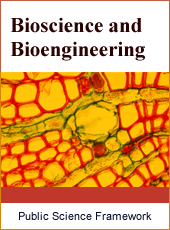Bioscience and Bioengineering
Articles Information
Bioscience and Bioengineering, Vol.2, No.1, Feb. 2016, Pub. Date: Feb. 16, 2016
Investigation of Mixing Type in Pre-Treatment Unit Reactors; Biological View
Pages: 8-12 Views: 3688 Downloads: 1131
[01]
Sahar Barghpeyma, Department of Chemical Engineering, Sirjan Branch, Islamic Azad University, Sirjan, Iran; Department of Chemical Engineering, Sirjan Science and Research Branch, Islamic Azad University, Sirjan, Iran.
[02]
Farshad Farahbod, Department of Chemical Engineering, Firoozabad Branch, Islamic Azad University, Firoozabad, Iran.
Wastewater from the desalination unit of petrochemical industry is used in treatment tanks. Experiments are held with three different types of impellers in the treatment tanks and the amounts of chemical oxygen demands, biological oxygen demands, turbidity of the clear solution, CO2 and sedimentation time are measured in each runs. Mixers are composed of a mechanical part called the head and hydraulic part called the impeller which is the core of the mixer.
Wastewater, Mixing, BOD, COD, CO2, Treatment
[01]
A. Malakahmad, A. Hasani, M. Eisakhani, M. Hasnain Isa, Sequencing Batch Reactor (SBR) for the removal of Hg+2 and Cd+2 from synthetic petrochemical factory wastewater., J. Hazard. Mater., 191, (2011) 1–3, 118-125.
[02]
A. Thill, S. Moustier, J. Aziz, M.R. Wiesner, J.Y. Bottero, Flocs restructuring during aggregation: experimental evidence and numerical simulation, J. Colloid Interface Sci. 243 (1) (2011) 171–182.
[03]
B. Xie, S.B. Liang, Y. Tang, W.X. Mi, Y. Xu., Petrochemical wastewater odor treatment by biofiltration. Biores. Techn., 100, (2009), 7, 2204-2209.
[04]
C.C. Kan, C.P. Huang, J.R. Pan, Coagulation of high turbidity water: the effects of rapid mixing, Water Sci. Technol.: Water Supply 51 (2002) 77–85.
[05]
C. K. Lin, T.Y. Tsai, J.C. Liu, M. Ch. Chen, Enhanced biodegradation of petrochemical wastewater using ozonation and bac advanced treatment system Water Res., 35, (2001), 3, 699-704.
[06]
C. Li, Sh. Zhong, L. Duan, Y., Song. Evaluation of PetrochemicalWastewater Treatment Technologies in Liaoning Province of China Proce. Environ. Sci. part C, 10, (2011), 2798-2802.
[07]
D.H. Bache, C. Johnson, J.F. McGilligan, E. Rasool, A conceptual view of flo in the sweep floc domain, Water Sci. Technol. 36 (1997) 49–56.
[08]
D. Teresa Sponza, R. Oztekin, Removals of PAHs and acute toxicity via sonication in a petrochemical industry wastewater. Chem. Engin. J., 162, (2010), 1, 142-150.
[09]
E. Vaiopoulou, P. Melidis, Alex. Aivasidis, Sulfide removal in wastewater from petrochemical industries by autotrophic de nitrification. Water Res., 39, (2005), 17, 4101-4109.
[10]
F. Ma, J.-bo Guo, L. jun Zhao, Ch.chi Chang, D. Cui, Application of bioaugmentation to improve the activated sludge system into the contact oxidation system treating petrochemical wastewater. Bioresource Tech., 100, (2009), 2, 597-602.
[11]
H. Patel, D. Madamwar. Single and multichamber fixed film anaerobic reactors for biomethanation of acidic petrochemical wastewater-systems performance Process Biochemistry, 36, (2001), 7, 613-619.
[12]
H. Zhang, Y. He, T. Jiang, F. Yang. Research on characteristics of aerobic granules treating petrochemical wastewater by acclimation and co-metabolism methods. Desalination, 279, (2011), 1–3, 15, 69-74.
[13]
J. Duan, J. Gregory, Coagulation by hydrolyzing metal salts, Adv. Colloid Interface Sci. 100–102 (2003) 475–502.
[14]
J. Gregory, Polymer adsorption and flocculation, in: C.A. Finch (Ed.), Industrial Soluble Polymers, Royal Society of Chemistry, London, 1996, 62–75.
[15]
J.L. Lin, C.P. Huang, C.J.M. Chin, J.R. Pan, Coagulation dynamics of fractal flocs induced by enmeshment and electrostatic patch mechanisms, Water Res. 42 (2008) 4457–4466.
[16]
J.L. Lin, C.P. Huang, J.R. Pan, D.S. Wang, Effect of Al (III) speciation on coagulation of highly turbid water, Chemosphre 72 (2008) 189–196.
[17]
K. Ebie, Y. Azuma, Reducing turbidity and coagulant residue in treated water through optimization of rapid mix condition, Water Sci. Technol.: Water Supply 2 (2002) 103–110.
[18]
K.J. Ives, The Scientific Basis of Flocculation, The Netherlands, Alphnvan der Rijn, 1978.
[19]
K. Lin, H.T. Hsu, Y. Ko, Z.X. Shieh, H-L. Chiang, Pyrolytic product characteristics of biosludge from the wastewater treatment plant of a Chiang petrochemical industry, J. Hazard. Mater. 171, (2009), 1–3, 208-214.
[20]
L.Ch. Wang, I.-Ch. Wang, J.E. Chang, S.O. Lai, G. P. Chang-Chien, Emission of polycyclic aromatic hydrocarbons (PAHs) from the liquid injection incineration of petrochemical industrialwastewater., J. Hazard. Mater., 148, (2007). 1–2, 296-302.
[21]
L. Wang, S. Barrington, J.W.Kim, Biodegradation of pentyl amine and aniline from petrochemical wastewater. J. Environ. Manage., 83, (2007) 2, 191-197.
[22]
M. Aliabadi, A. Aroujalian, A. Raisi, Removal of styrene from petrochemical wastewater using pervaporation process. Desalination, 284, (2012), 116-121.
[23]
M. Anbia, S. Ershad Moradi. Removal of naphthalene from petrochemical wastewater streams using carbon nanoporous adsorbent. App. Surf. Sci., 255, (2009), 9, 5041-5047.
[24]
M.A. Yukselen, J. Gregory, The effect of rapid mixing on the break-up and reformation of flocs, Chem. Technol. Biotech. 79 (2004) 782–788.

ISSN Print: 2381-7690
ISSN Online: 2381-7704
Current Issue:
Vol. 6, Issue 3, September Submit a Manuscript Join Editorial Board Join Reviewer Team
ISSN Online: 2381-7704
Current Issue:
Vol. 6, Issue 3, September Submit a Manuscript Join Editorial Board Join Reviewer Team
| About This Journal |
| All Issues |
| Open Access |
| Indexing |
| Payment Information |
| Author Guidelines |
| Review Process |
| Publication Ethics |
| Editorial Board |
| Peer Reviewers |


